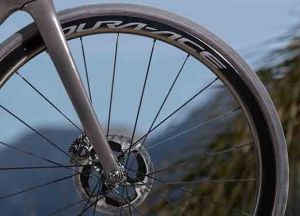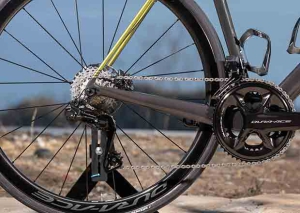I confess I had not previously been moved by Shimano’s wheels. Neither lover nor a hater. They were fine. Trustworthy, but not my idea of cutting edge. I guess I’ve felt that Shimano made the wheel I really wanted, just, three or years after “that” wheel had already hit the market with some other brand’s logo in it. I’ve been more keen to ride Zipp, HED, ENVE, CADEX, with DT Swiss probably leading the way in hub design. I’ve got to revise my opinion after the wheels Shimano just released at the Dura Ace and Ultegra level.
You may have missed this release because the embargo on these wheels lifted the same day as the (12-speed) 9200 and 8100 groupsets. Shimano has not only caught up in features to the wheels I prefer to ride, there are some decades-old design motifs that are regretfully no longer an option for me with other wheel brands, but i get these features with Shimano.

Let’s dispense, quickly, with all the stuff Shimano probably wants me to talk about because it’s not the stuff about these wheels I want to talk about. The new wheels introduced are the C36, C50 and C60_HR, and those numbers refer to the depth: 36mm is a standard road wheel, very lightweight; 50mm is the wheel I’ve been riding, which is just a good, all around, road wheel; 60mm is more of a sprinter’s wheel because of its stiffness and aerodynamics. If it’s a Dura Ace, the nomenclature goes like this: WH_R9270_36_TL. I wrote about Shimano’s nomenclature and 9270 is the code for new 12-speed Dura Ace (9200) in the hydraulic disc brake motif (that final “70”, making it 9270). The R is for road; the TL is for tubeless, and this wheel is also made in a tubular (sew-up tire) version.
That 36mm wheelset is very light at 1338g per pair, and that is on par with the lightest road wheelsets made these days. The 8170 (Ultegra) wheelset in 36mm is about 150g heavier and that’s also on par with the weights of not-quite-halo-priced premium road wheelsets. These wheelsets improve on the aerodynamics of the Shimano wheels they replace by perhaps 3 or 4 watts if one compares wheel of identical depths, though in the graphs I saw the speed at which those watts are saved is not listed. (30mph is my guess; if it turns out I'm wrong I'll post the edit here.)

These wheels – especially the 60mm wheels - would be fine for timed racing and tri but these are road wheels, make no mistake (which is great, because while I race triathlons I spend most of my time riding either my road or my gravel bike). These wheels are made to be aero, but in the context of road: sprinting, descending, turning, handling and so on. Shimano has spent a lot of time thinking about this, and the C60 wheel has (for example) twice as many spokes on the drive side than on the brake side. Likewise my C50 wheel, which has 16 spokes on the drive side (the side more subject to wind-up during sprinting) and 8 on the disc brake side.
Shimano adopts features I need
Shimano has got religion on wider inner beads. Not all wheel brands have; Shimano isn’t the last to do this. But wheel brands like ENVE and HED got that ball rolling, Zipp next, then CADEX, and now if you don’t have an inner bead with on your road wheels of at least 20mm then I’m probably not going to buy or ride your wheel. The inner bead width on these 9270 and 8170 wheelsets is 21mm. This means you can put larger road tires on there – from 28mm to 32mm, which is all I ride anymore for road – and the tires don’t look like lollipops on a stick the way they do on 17mm and 19mm bead diameters. I can run lower pressures, and while I believe the market is moving toward hookless beads we’re in a transition period, where tire makers are transitioning to models that are ETRTO-compliant for hookless beads. The image below looks like a hookless bead bit it isn't. Because there is a bead hook I can ride pretty much any tubeless road tire I want on these wheels.

What’s old is new
It’s the hub where things get interesting. Here is where Shimano new-schools the freehub inners, but it also continues with some functionality less often seen over the past 30 or 40 years. Maybe other hub makers are doing this and I just didn’t get the memo; but I certainly notice this with Shimano.
To get to the hub’s inners, you will need to deploy a couple of 17mm cone wrenches to get the end caps off. I don’t mind this, because...

...if I pick up one of these new fangled rear wheels from a different brand, especially if it’s got one of those huge pie-plate 1x cassettes on it, the cassette, along with the driver body, is liable to just fall onto the ground, me holding what remains of the wheel in my hand. Depending on the kind of hub engagement the hub gears and springs, or the pawls, fall out and I have to hunt around on the ground for them. End caps just fall off. This is just the way it is these days with wheels. If you bring a second wheelset with you in the car you have to really watch to make sure all the parts remain with the wheel. I am therefore not inconvenienced with end caps that thread on.
On the rear wheel, non-drive-side, once you take off an end cap this reveals a second nut, like a kind of inner end cap, also threaded onto the axle, which you also tighten or loosen with a 17mm end cone wrench. On the inside of this cap is a bearing race (image above) pressing on an old school ball-and-cage bearing like I haven’t seen in a hub in at least 30 years (except with Shimano). In the old days we could expose these bearings in our wheels, which meant we could decide what kind of lubrication we put on them; and how precisely we wanted these bearing races to sit against the balls in the bearing cages. In fact, as I recall some hubs didn’t have cages at all, just the balls against the races.

You can see what this looks like on the drive side above. The front hubs (below) are the same way. The front hub end caps are end caps on the outside, bearing races on the inside and that’s that. They are quite well sealed, so, it seems to me these hubs give you the benefit of sealed bearings with the freedom to precisely adjust the pressure on the bearings; change the lube to suit the use; and to service the hubs.
This also gives you the freedom to mess things up (crush the races through overtightening; or you’ll get play in the hub if you undertighten). So, don’t get into these hubs unless you know what you’re in for. If you do choose to service these hubs, be careful about grease on the freehub mechanism; Shimano is very particular about what you do and don't lube in there.
If you are a student of hubs like this, and you respect the tech, your bearings will last longer; perform better under a lateral load; you can microadjust the pressure of the races against the balls; and you can lube for speed or lube for other imperatives.

That’s how these Shimano hubs are. Mind, they’re direct engagement hubs, which feature gears and springs rather than pawls and ratchet rings. DT Swiss’s hubs, and Zipp’s Cognition hubs, are like this, as well as the hubs of a lot of wheel brands that deploy this tech. These hubs are very new-tech. But this one old-school feature is cool. In the old days you could dial those old hubs so precisely, you could hold the front wheel in your hands, spin it, and it would rotate for days. Your arms would wear out before the wheel stopped. Yes, it was great when sealed bearings came along because… no more maintenance! However, you lost the capacity to get those wheels to spin with absolutely, positively the least possible friction. You were tied to whatever friction those sealed bearings gave you.
Ultegra
These wheels at the Ultegra level are priced at a pretty reasonable – for what they are – $1,399 a pair. The C36 weights 1,488g for the set and this compares well to, say, the Zipp 303S in weight, price and features (wide inner bead, deep well, etc.). Like the 303S, the Ultegra wheelset does not have this new clutch-style, direct engagement freehub system (it’s got traditional pawl-and-ratchet-ring).

The one regret about Shimano’s wheels is that you don’t have the freedom to change a freehub body and ride these wheels with a SRAM groupset. One can understand why. Nevertheless, I appreciate when I can ride any wheelset with any bike. I have two road bikes right now, one SRAM Force AXS and one Shimano 9270 Dura Ace, and several wheelsets I can ride with them. The Zipp and CADEX wheels I can ride with either bike because I have swappable driver bodies for each. Not so these Dura Ace wheels.
The wheels I’ve been riding around on are WH-R9270 C50-TL and yes, they’re pricy at $2,099 but compared to those in its competitive set they are actually not pricy. The hub tech, weight and other specs are more typically found in wheels from $2,400 to $3,200 a pair. The hard part is getting them, in this era of COVID-encumbered shipping delays.



